If you’re a bird watcher, much like myself, you probably enjoy learning new things about the birds we love to watch.
One of the things I recently learned during a bird watching trip is what great blue herons eat and, even more so, how they obtain food in the winter when many waterways are frozen, at least in my neck of the woods, that is.
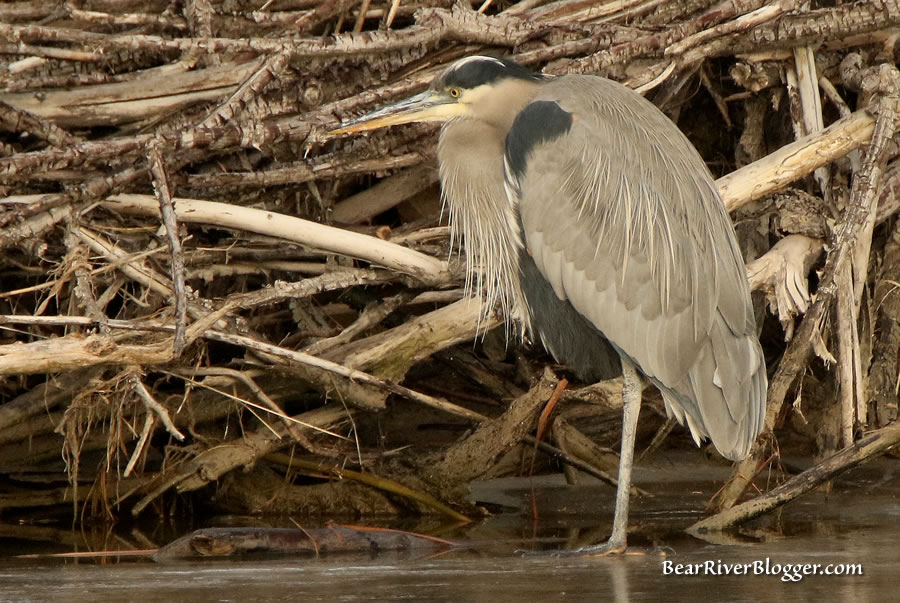
Great blue herons eat mainly fish, but they also have a wide variety of other food sources in their diet when fish are scarce, including mice and other rodents, crayfish, small birds, frogs, salamanders, turtles, snakes, and even insects whenever the opportunity arises.
Over the past couple of weeks, I have spent several days photographing great blue herons on my favorite bird-watching spot, the Bear River Migratory Bird Refuge, located in Brigham City, Utah.
It is a nearly 77,000 acre federally managed wildlife refuge geared towards birds and bird habitat.
Both migratory and resident birds call the Bear River Refuge home, including one of my favorites, the great blue heron.
Great blue herons are an interesting bird for sure, especially during the winter on the refuge.
These long-legged egret-like birds offer an interesting winter setting for us bird watchers to both observe and photograph.
They can often be found during the cold winter season hunkered over a small, nearly frozen-over fishing hole, much like I have endured countless times during my ice fishing days.
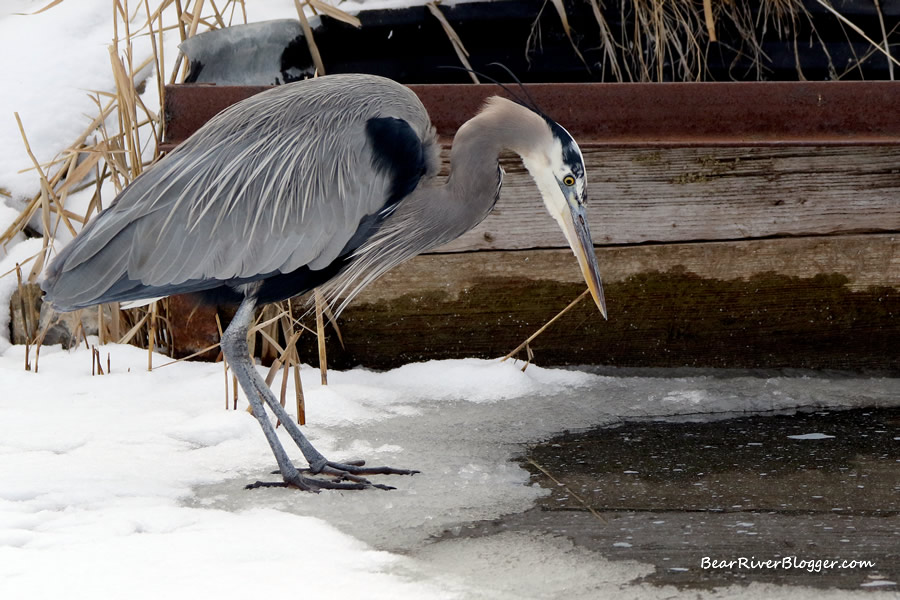
For this part of the country, west of the Rockies, the great blue heron isn’t much of a migratory bird, per se, and mostly stays put year-round with short, local excursions to find food and open water when winter conditions are extreme.
On the Bear River Migratory Bird Refuge, the great blue heron lives and hunts throughout the year without going very far, except during extreme winters when open water is nowhere to be found.
This includes the harshest parts of the calendar, the dead of winter when most of the refuge has given way to the cold, icy grip of winter and when most birds have headed south for warmer climates and more abundant food.
Great blue herons are quite adept at utilizing shallow water to hunt for food.
With their long legs and long sharp beak, perfect for spearing fish and other creatures in shallow water, great blue herons are built for hunting around shallow, slow-moving water.
It’s not to say you will never see a great blue heron in a dry, upland type of habitat searching for a different kind of meal, I have on several occasions, but those moments are typically the exception to the rule.
That is, however, at least from what I have observed, from my many years of bird watching on the Bear River Migratory Bird Refuge.
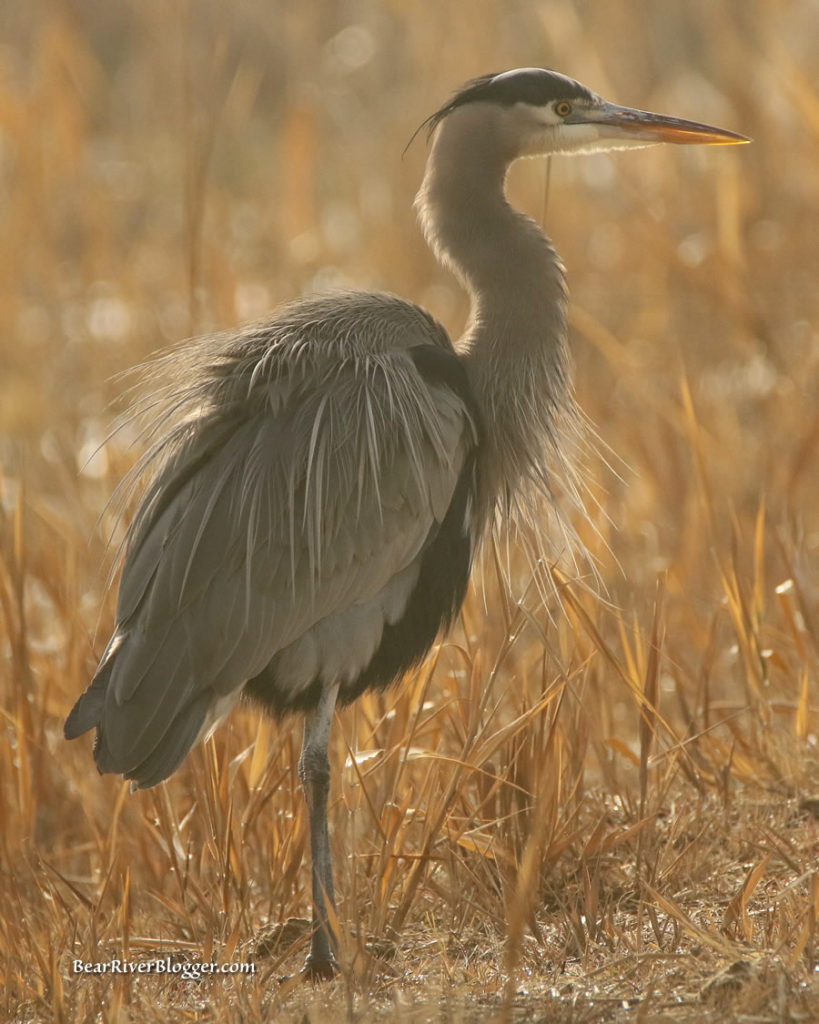
In confession, I have indeed seen herons stalking in the grass, far away from water, but for me, at least, these occurrences are very seldom.
The Bear River Refuge is primarily a marsh habitat and herons don’t have to go far to find water so hunting dry habitats aren’t needed as much as in other parts of the country where abundant wetlands might not be as plentiful or as large.
Because herons prefer to hunt around water, this makes it tough during the cold winter season when iced over waterways prevail, but we will get to that in a moment.
For now, just keep in mind great blue herons prefer water when at all possible looking for food.
What is a Great Blue Heron?
You have probably seen a great blue heron if your birding endeavors have taken you around a wetland or a shallow river.
As I have mentioned before, great blue herons prefer water and they are of the same family as egrets and bitterns, both of which are also water-dependent predators.
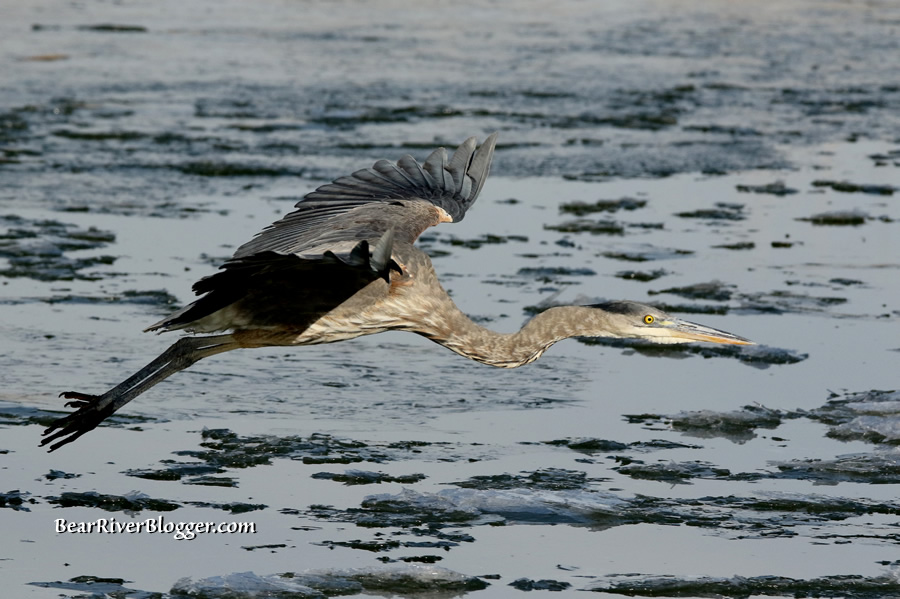
The blue heron is a rather tall, grey feathered bird with a long, sharp beak designed for plucking fish and other creatures from shallow water.
They have long legs which allow them to wade in shallow water at varying depths in search of food.
One of the most notable characteristics of the great blue heron is their innate ability to stand perfectly still while fishing, thus keeping themselves from distracting nearby prey.
Great blue herons are also pretty stealthy when cautiously stalking prey in shallow water, moving ever so slowly as to not be detected by fish and amphibians just below the surface of the water.
What Does a Great Blue Heron Eat?
Great blue herons are carnivorous, meaning they eat meat from other living creatures. The blue heron diet is both variable and adaptable with fish being the most common part of its diet.
But the great blue heron also eats other waterborne creatures such as frogs, amphibians, and turtles as well as snakes, rodents, insects, and even small birds when needed.
This kind of diet allows them to live and spend winters further north than most other herons when waterways freeze.
Keep this menu in mind for a bit as it will be part of an interesting hunting behavior for the great blue during winter when mother nature has locked up most of the available water.
An interesting feeding choice regarding great blue herons I have personally observed, once, that is, is they don’t seem to care to scavenge on dead things like bald eagles and other carnivore-minded birds do.
I can’t say from a scientific standpoint this is always the case but I did have an experience with several herons and a dead fish this past week which caused me to think they prefer live food over something already dead.
Last week, on one of my refuge trips where I photographed an immature bald eagle hunting grebes, I noticed a dead fish laying on the ice just a few feet from several great blue herons.
None of the herons showed any interest in the dead fish, but a hen mallard was gorging herself on the carcass. It was quite an interesting behavior by a duck I had never seen before.
It seemed by this observation, herons prefer a living, fresh meal over dead food.
I have never seen a heron pick at a dead fish or animal in the past, but I was shocked to see so many hungry herons chasing grebes for their meals without showing any regard for an easy meal with the dead fish just a few feet away.
How Does a Great Blue Heron find Food During Winter?
This is one of the most fascinating behaviors I have personally observed in the bird world. As I have mentioned before, herons primarily use water to find food. Not always, mind you, but most of the time.
The icy waters during winter cause a dilemma during the cold winter months for herons, especially when moving bodies of water, such as rivers, freeze up.
The easiest way I can describe it is to think of an ice fisherman sitting by a small hole waiting for the rod to bounce.
Great blue herons will seek out even the smallest pockets of open water to fish from and, much like us human ice fishermen, they will stand there for hours at a time, if needed, in hopes of a meal.
As they guard even the smallest of holes left open by current or water control structure, the heron will immediately plunge their head, sometimes their whole body, into the water when an unsuspecting fish swims by.
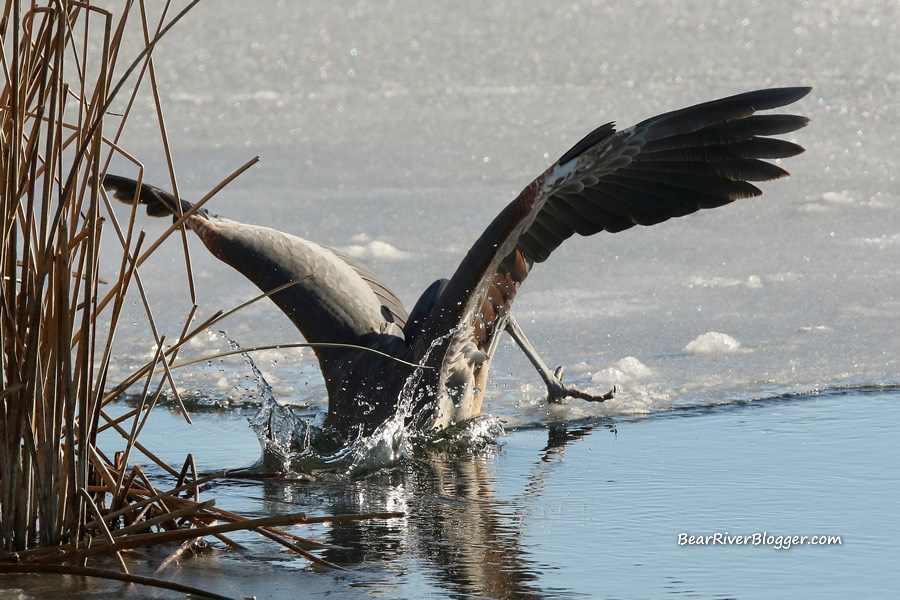
During a recent winter as I was photographing herons on the ice, I postulated a question I just could not seem to answer, what happens if the available ice hole is not by a shallow part of water?
Fish tend to stay in the warmer parts of the water and in some habitats that can be several to many feet below the water’s surface, much too deep for a heron to fish from while on its icy perch above.
My question was eventually answered a couple years ago, on Christmas eve, in fact. I was photographing a great blue heron on the iced-over Bear River, where I knew the water was deeper than a heron could successfully fish.
I started to notice pied-billed grebes and a variety of diver ducks, including goldeneyes and mergansers, diving down below the ice.
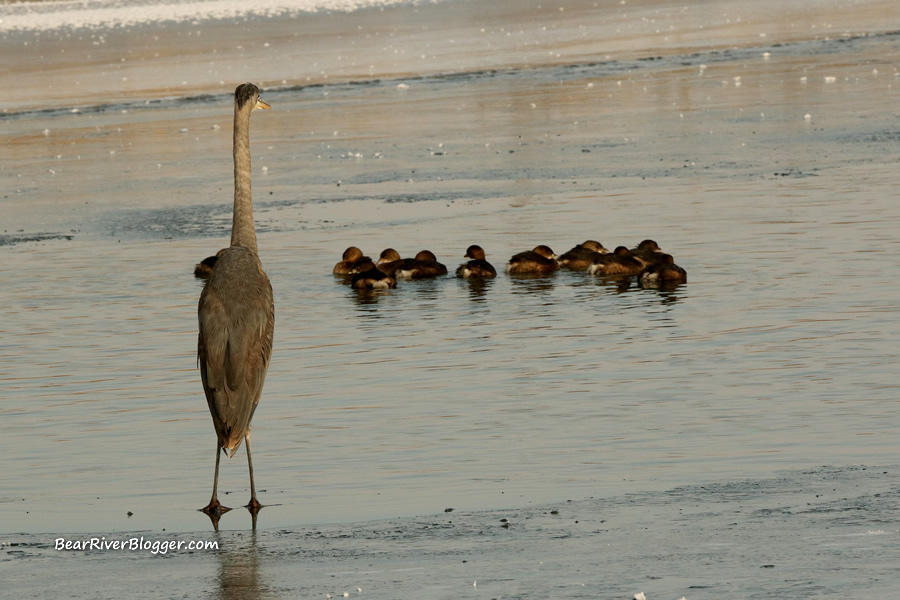
Occasionally, these water birds would come up with a small fish and my question was quickly answered.
The great blue herons would rush over and try and scare the grebe or duck in hopes of it dropping its newly acquired meal.
You see, the heron utilizes a tactic often found in nature where one animal intimidates and steals its meal from another bird.
Once I saw this, I started to notice this unique and strange behavior over and over since then.
I have actually seen this during the summer months as well when food is more plentiful so this behavior is not characteristic to just the winter season.
In fact, now that I have seen it and I know what to look for, I commonly find great blue herons congregating along the icy edges of open water where pied-billed grebes and other diving birds have set up shop.
Do Great Blue Herons Eat Rodents
During winter in colder climates where waterways freeze, great blue herons do indeed hunt for and eat mice and voles.
This ability to hunt for and eat rodents allows the great blue heron to stay further north and not have to migrate during winter in many regions across the United States.
Just recently, in fact, I was at the Farmington Bay WMA and witnessed a great blue heron slowly stalking the roadside vegetation where it successfully caught and ate a vole.
Most of the water on the preserve was frozen so this particular great blue heron was hunting the tall grass in search of rodents, something I have never had the opportunity to photograph before until now.
The following image is from that day, just a couple of weeks ago, during the last week of January.
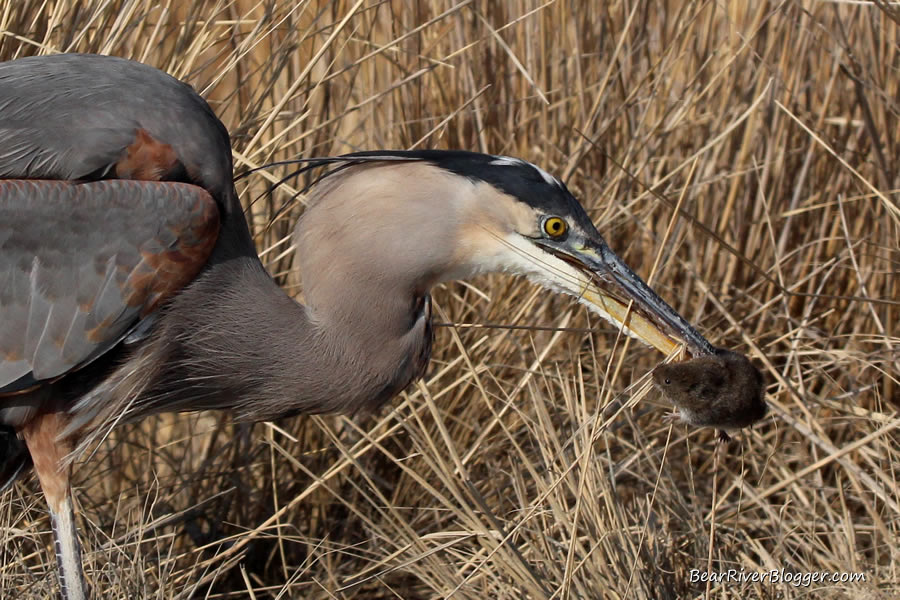
Where Can I See Great Blue Herons
As mentioned earlier, great blue herons live around water and can be seen in marshes, along rivers and tide-flats, and around shallow lakes, pretty much anywhere there is shallow water, still or slow-moving, where they can stalk waterborne creatures such as fish, frogs, and amphibians.
Great blue herons can be seen almost daily on the Bear River Migratory Bird Refuge throughout the entire year.
This federally managed wildlife sanctuary is the perfect habitat for herons and a perfect opportunity for birders, such as you and me, to observe them year-round along the 12-mile self-guided auto tour route.

Great blue herons don’t migrate from the refuge, per se, but they do move around a lot, especially during the winter months in search of open water.
During the summer months, these large birds can be found just feet from the gravely auto tour route as they fish in the shallows.
During winter, open pockets of water on the Bear River and on the array of water delivery canals provide places for the heron to hunt and find food.
Great Blue Heron Facts
For those of you who like herons as much as I do, here are a few interesting facts about the great blue heron I have found from books I own as well as from the Audubon Society website.
- Scientific Name: Ardea herodias
- Both parents feed the young by regurgitation.
- Young great blue herons are capable of flight in about 60 days.
- Great blue herons breed in colonies, often times with other wading birds, but rarely in isolated pairs.
- Northern great blue heron populations east of Rockies are migratory with some going to Caribbean, Central America, or northern South America while populations along the west coast are more permanent.
- Herons lay 3-5 pale blue eggs, sometimes 2-7, with incubation lasting 25-30 days and is cared for by both parents.
- The great blue heron average lifespan is about 15 years
- Great blue herons nests in trees and shrubs but will also nest on artificial nesting platforms when they are made available.
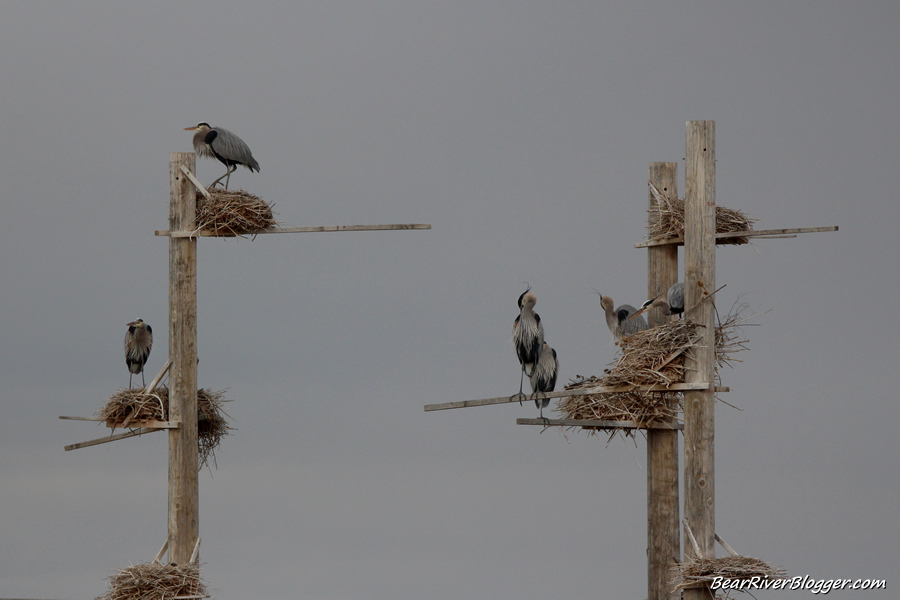
Where Can I Go To Photograph The Great Blue Heron
The best location for photographing the great blue heron is the Bear River Migratory Bird Refuge self-guided auto tour route, a 12-mile gravel road that winds through the Bear River Refuge wetlands where oftentimes great blue herons can be seen and photographed in very close proximity to the road.
Great blue herons live on the refuge year-round, but summer is the best time of year to find and photograph the great blue herons on the Bear River Bird Refuge.
They wade in the shallow waters in search of fish and aquatic insects all around the auto tour route so finding one is usually very easy most days, especially during mid-week when vehicle traffic is far less than on the weekends.
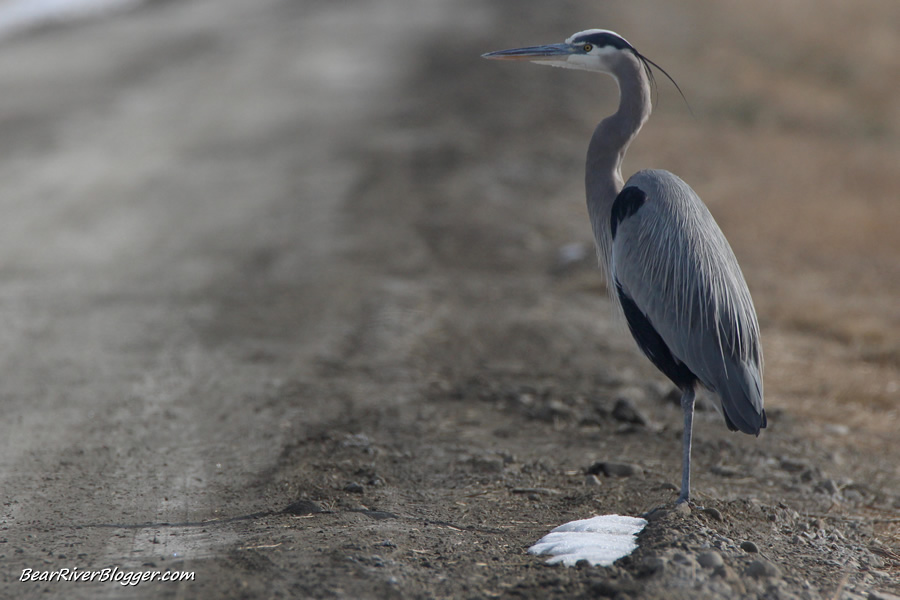
Another great place to photograph and view great blue herons is Farmington Bay WMA. This state-owned nature preserve is the best place to view and photograph a nesting colony of great blue herons.
Several artificial nesting platforms have been erected which attract and support numerous pairs of nesting great blue herons, all of which are easily viewed and photographed from the visitor’s center parking lot.
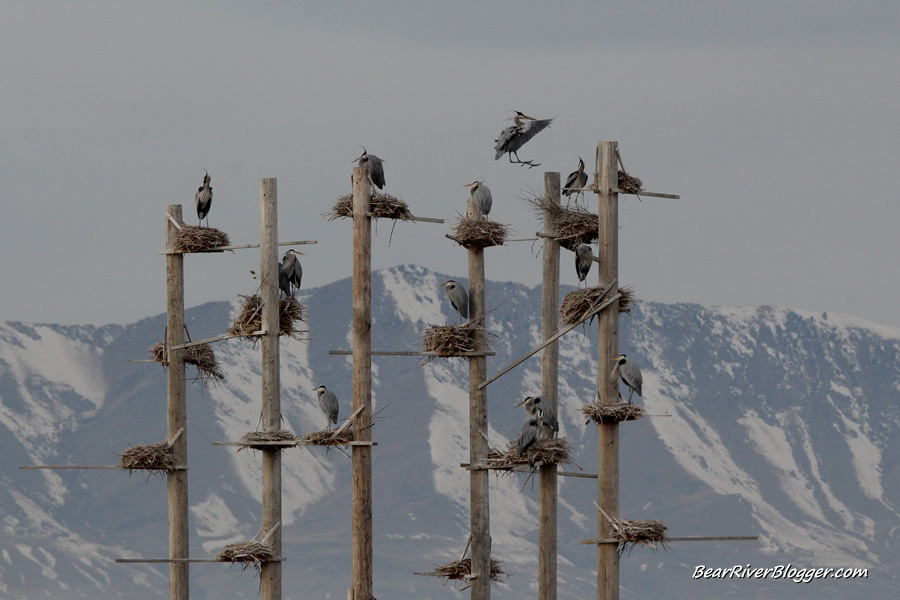
More Information About The Bear River Migratory Bird Refuge
If you are interested in visiting the Bear River Migratory Bird Refuge, I urge you to visit their website. It contains their contact information, social media outlets, and more information about the refuge and the birds and habitat found on the sanctuary.
They have a great visitors center with many things to see and do, including a terrific movie about the refuge and a bookstore with nature-related gifts, including some of my own photographs from the refuge.
Conclusion
Great blue herons are primarily fish-eating birds but can and often times do eat other critters such as frogs, snakes, amphibians, rodents, and even small birds.
They can be found in a variety of habitats where water is prevalent, such as marshes, rivers, shallow lakes, and tide flats.
I find them almost daily on the Bear River Migratory Bird Refuge and I have witnessed some unique and interesting behavior over the years. This is why I love nature and bird watching, there is always something new to learn and observe.
If you are a birder or a nature lover as we are, we offer you to subscribe to this blog and receive email notifications for future posts. Check your spam folder if you don’t receive a confirmation email shortly after registration.






